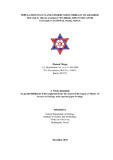Please use this identifier to cite or link to this item:
https://elibrary.tucl.edu.np/handle/123456789/1456| Title: | Population Status and Conservation Threats to Assamese Macaque (Macaca Assamensis M’clelland, 1840) in Shivapuri Nagarjun National Park, Nepal |
| Authors: | Thapa, Pramod |
| Keywords: | Assamese monkey;Crop damage,;Nagarjun forest;Population distribution;Threats;Vegetation |
| Issue Date: | 2018 |
| Publisher: | Central Department of Zoology |
| Abstract: | Systematic studies of less common primate species Assamese macaque is rare in Nepal, so to explore the population dynamics and threats to the macaque this study was carried out in the Nagarjun Forest of Shivapuri Nagarjun National Park (SNNP) from August 2017 to July 2018. A total of 145 Assamese macaques (Macaca assamensis) were encountered in 7 groups within the total area surveyed of 16 km² in Nagarjun Forest of SNNP by head count or direct count method. The group density was found to be 0.4375 groups/km² with a crude (population) density of 9.0625 individuals/ km² and a mean group size of 20.7142 individuals, range 11-41 individuals. Age-sex composition of macaque comprised 18.621% adult males, 24.138% adult females, 13.793% sub adult male, 11.034% young female, 9.655% Juvenile male, 11.724% juvenile female and 11.034% were infants in the study area. The adult sex ratio and the recruitment rate were found to be 0.771:100 (77male per 100 females) and 2.187:1 (218 female per 100 infant) respectively. Total 16 Quadrate of 20x20m, 44 plant species with 376 number were recorded from Nagarjun forest. This study revealed that Chilaune (Schima wallichii) is the dominant plant species with relative density 10.37% and relative frequency 8.27% followed by Musure kattus (Castonopsis tribuloides) with relative density 9.30% and relative frequency 7.51%. In the two buffer zone VDCs of Nagarjun forest, questionnaire survey was conducted to the local people who are directly involved in agriculture and reported crop raiding as the major problem. Crop mostly preferred includes maize (53.17%), Wheat (15.6%), Millet (7.33%), Paddy (11.93%), Vegetables (7.56%) and Fruits (4.41%). To protect crop fields, local peoples used patrolling and guarding the fields (42%), Tin-box and throwing stone with “Catapult” (13%), using dogs (11%), shouting and chasing (24%), and other methods like fencing with thorny twigs, trapping and caging, scarecrows etc. (10%) were used. Only 15% of the respondents approved that monkeys should be conserved, a majority of 85% don’t feel that it is necessary to conserve the animal. Majority, 52% of local respondent agreed with retaliatory killing was the major threats to monkey, meanwhile 13% agreed with encroachment, 12% habitat destruction, 6% forest fire, 8% disease and 9% respondents stated they have no idea about the threats to monkey. Most of the local peoples (49%), suggested proper monetary compensation is appropriate for the reduction of intensity of conflict, 21% of people said that they should be killed, 19% of total respondents stated that translocation of monkey is another remedial measure. Patrolling and guarding of the crop field by security personnel (Army, Armed Police force) on the regular basis, was suggested by 6% and 5% of respondents didn’t have any suggestion to give. Key words: Assamese monkey, Crop damage, Nagarjun forest, Population distribution, Threats, Vegetation. |
| URI: | http://elibrary.tucl.edu.np/handle/123456789/1456 |
| Appears in Collections: | Zoology |
Files in This Item:
| File | Description | Size | Format | |
|---|---|---|---|---|
| Pramod Thapa_5.pdf | 3.42 MB | Adobe PDF |  View/Open |
Items in DSpace are protected by copyright, with all rights reserved, unless otherwise indicated.
